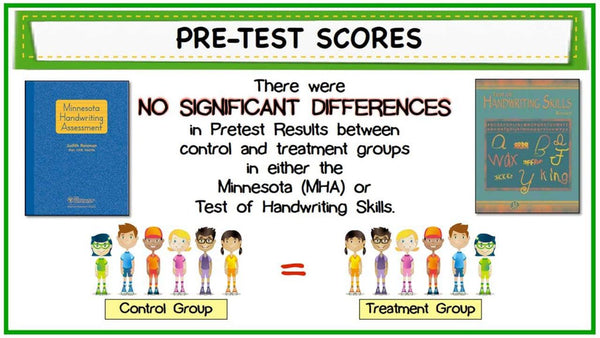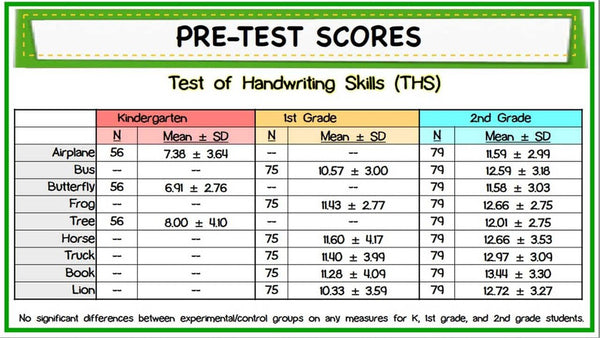According to the SPSS, there were no significant differences between the scores for the control and treatment groups in either the Minnesota (also known as the MHA) and the Test of Handwriting Skills (also known as the THS). In other words, both the control groups and treatment groups were comparable.
Are you familiar with the Minnesota? Many therapists and teachers are or have seen a version of it. It was created by an Occupational Therapist, Judith Reisman, and is a copying test. Children are given the sentence,
“The quick brown fox jumped over the lazy dog” on a single sheet of lined paper and are instructed to copy each word as neatly as possible. They are not told to hurry, but they are timed.
- The test paper has a descender line and a dotted middle line and has arrows to indicate the base line onto which the children should start writing.
- The challenge is that all the words are scrambled. That’s so it’s not a spelling or memorization test.
- Also, the children must write on lines several rows below the prompt. In other words, this is not a direct line copy where the prompt is DIRECTLY above the lines a child must write on.
The Minnesota is a norm-referenced assessment. To qualify as a scorer… and remember, this was only for the first and second graders, therapists had to score a sample test and earn an inter-rater reliability score of .80 or higher.
And this is what the Pretest Results looked like for the Minnesota.
First, I should say that the standards for scoring were stated in a way that compared results qualitatively with grade-level peers. So, the three options were:
- Performing like peers
- Performing somewhat below peers, or
- Performing well below peers
Here are how our children looked going into the study:
- In terms of Rate, both the first and second graders printed at a rate commensurate with the peers.
- However, when it came to Legibility, both grades—first and second, and groups—control and treatment started out somewhat below peers
- With Form, the first graders in both groups were somewhat below their peer’s performance, but the second graders were well-below their peers
- Alignment was somewhat below peer levels for both grades and groups
- Size was somewhat below peer levels for both grades and groups
- And spacing was comparable to grade level peers for the first graders, but somewhat below peers for the second grades.
Overall, that meant that our study group, both the control and treatment groups began the study already behind the eight ball.
In terms of a graph with the actual test scores and standard deviation, it looked like this: You can see, wherever there is a 1, that the test showed no significant differences between the experimental and control groups for kindergarten, first or second grade. That essentially meant that the grades and groups were comparable.
- A 2 indicates tests that showed students performing like peers, this included RATE and SPACING for first grade, and only FORM for second.
- A 3 indicates performance somewhat below peers. That would include LEGIBILITY, FORM, ALIGNMENT AND SIZE for first grade. And LEGIBILITY, ALIGNMENT, SIZE and SPACING for second grade.
- A 4… Don’t want you to miss that… indicates performance well below peers. This was where second graders scored on FORM… Well below grade level peers.
The Test of Handwriting Skills was the other handwriting assessment given. It is the ONLY standardized handwriting assessment… all others, like the Minnesota… are norm or criterion referenced.
This is a relatively easy test to administer. It is however, a bear to score!
This test includes a booklet of 10 different subtests, one booklet per child. The standardized booklet pages are essentially blank, with only pictures in the lower left corner hinting to the different subtests. That’s done to minimize the near point letter references. However, since we were comparing the treatment population to themselves, we adapted the test booklet with kindergarten, first, second or third grade lines. That was essential since our premise was that it’s all about letter size.
To qualify as a score on the THS, therapists had to watch a 2-hour training video. On it, the author discussed in detail the various criterion for scoring a letter a 3, a 2, a 1 or a 0. In other words, partial credit could be given…. Unlike the Minnesota where letters either complied with the criterion or did not.
For those unfamiliar with the THS, it works like this: As I said before, on a typical test booklet, each page would be blank. For our purposes (and since we were comparing students to themselves and not to their peers, we adapted each page with K, 1st of 2nd grade lines, maintaining the same picture key.
In the lower left corner, would be the following pictures: plane, bus, butterfly, frog, bicycle, tree, horse, truck, book, or lion.
- Subtest 1 had a picture of a plane. On the page, children were instructed to write the entire upper-case alphabet from memory. This test was given to kindergarten and second grade.
- Subtest 2 had a picture of a bus. If this page was in front of the children, they were told to write the lower-case alphabet from memory... as many letters as they could. This subtest was given to first and second graders.
- Subtest 3 had a picture of a butterfly. The instruction was to write upper case letters as they were dictated. The order was random. Kindergarten and second grade completed this test.
- Subtest 4 had a picture of a frog. This subtest required students to write the lower-case letters from dictation. It was given to first and second grade.
- Subtest 6 had a tree in the corner. Here, for the first time, letters appeared on the page. Kindergarten and second-grade students had to copy the 12 letters.
- Subtest 7 was horse. Twelve lower case letters appeared on the page. First and second graders were told to copy them.
- Subtest 8 had a truck on it. This time, there were words… 6 of them. This subtest was given to first and second grade.
- Subtest 9 had a picture of a book. And on this page were 2 short sentences. This page was given to first and second grade, too.
- Finally, subtest 10, the Lion, required children to spell and print 6 words read aloud by the teacher. There was no visual cue. Once again, this test was only given to first and second grade.
I’m sure you noticed that there was no subtest 5. Subtest 5, the bicycle, was a number writing subtest. Since we didn’t have time to teach numbers, no one completed this test.
And this is what the pretest results looked like for all 3 grades for the various subtests. Statistically speaking, the standard deviations scores were not significant. In fact, on all the subtests, there was no significant difference between the experimental and control groups on any measure for kindergarten, first or second grade.




